I've always been fascinated by the solar lights that you typically can find in your backyard. I was always interested in how something in such a small package could have enough power to light up the dark and yet be able to recharge itself day after day.
While garden lights can be an attractive addition for your yard, I've always found the offerings at my local hardware store to be a bit ordinary and a bit boring for my tastes, and I wanted to use this self contained power source to do something different.
Since solar garden lights have gotten extremely cheap over the past few years, I've always found them fun and easy to experiment on in my attempt to find that cool and unique "thing" that I was looking for.
During the process of my experimentation, I learned how fairly straightforward the circuit actually was that made your typical garden light tick.
Recently, I came across an online vendor that sold LED's that had self contained circuits that replicated a flickering flame. Seeing these LED "sparked" (pun perhaps intended) the inspiration in me for a one of a kind garden light that I was looking for.
This garden light, built from bits and pieces that I had found around the shop, takes advantage of these special LED's, along with a very simple "roll your own" solar charging circuit that powers the LED when it gets dark out.
Step 1: Collecting the Parts
The heart of this project is the "hand built" solar powered circuit, however if soldering is not your forte, you can always substitute a circuit board from a regular solar light
Most of the components can be sourced from Digikey.ca but you would need to order the Flickering LED from PCBoard.ca
To make the garden light, you need to gather the following items:
Electronic Components:
- One 2"x2" perf board - I got mine at my local surplus store
- One Solar Cell (400mW 4.6V) - Digikey part number 1471-1517-ND
- One Photocell - Digikey part number PDV-P8104-ND
- One 2N3904 transistor - Digikey part number 2N3904FS-ND
- One Flickering LED - Yellow - PCBoard.ca part number YC259-04
- Two 100 Kilo Ohm resisters - I got mine from PCBoard.ca
- One 1N4006 Diode - I also got this from PCBoard.ca
- Black and red hook up wire
- One 2 AA battery box - I also picked this up at my local surplus store.
- 2 AA rechargeable batteries
Materials
- 13 inch piece of 1 x 6 pine
- 9 inch piece of half inch dowel
- One 125 ml Mason jar with lid - found in any store the sells canning supplies
- Exterior Paint - any color that you want
- Spar Varnish - any clear varnish is fine - but I like the look that Spar Varnish gives
- Frosted Glass paint
- 1 Foot of #1 Double Loop Utility Chain
- Two 1 inch Screw Eyes
- Hanging Plant Hook - I got mine at the local dollar store
- Wood Glue and hot glue sticks
- 1.5 inch brad nails
- Masking Tape
- Scrap Wood (for jigs)
Tools
- Miter Saw
- Router with a Corner Round Router Bit
- Rotary tool with carbide cutting bit
- Drill Press with:
- 2.5 inch hole saw
- 1.5 inch Forstner or spade bit
- 1/4 drill bit
- Dremel Trio or other small router with a 1/4 inch straight bit
- Brad nailer (I use an air nailer, but an electric or manual (ie hammer) nailer will work too.
- Soldering iron and solder
- Hot glue gun
- Small plastic container with water
- Square or Ruler
- Wire Strippers
- Optional - Multi meter
Step 2: Assembling the LED Circuit
The circuit that the drives the LED and turns it on when it's dark out is actually very straightforward. (I got the original concept for this circuit from the Radio Society of Great Britain's excellent "Radio and Electronics Cookbook")
The brains of the operation for the circuit is the photo cell that acts a variable resistor (low resistance in the daytime, high resistance when it's dark out) that is used to trigger the transistor - which is then used as a switch to turn on the LED.
The circuit is constructed using a small perf board where the components can be mounted in the pre-drilled holes of the board. The components are connected to each other on the board using a "dead bug" method (where the component leads are soldered to each other).
A full circuit diagram can be found below
Start by mounting the 2N3904 transistor in the middle of the perf board. Solder the transistor in place.
Next, mount the LED to the board and solder the positive lead of the LED to the Collector of the transistor.
Solder the unconnected leads for the 2 resistors together.
Finally, mount the photo cell to the perf board. Solder one lead of the photo cell to the two 1 Kilo Ohm resistors and solder the other lead of the photo cell to the Emitter of the transistor.
To allow for connections to the batteries and the solar cell, cut 4 hook up wires (preferably 2 red and 2 black wires). Solder one end of the 2 red wires to the LED and transistor Collector connection point. Solder one end of the 2 black wires to the photo cell and transistor Emitter connection point.
This should now give you a circuit that will turn on the LED when it gets dark. At this time give the circuit a quick test by hooking up the circuit to a battery source and turn off the lights - the LED should start flickering away! Likewise, with the lights on - the LED should go dark
As a final step, the circuit needs a certain degree of weatherproofing since the circuit will be spending it's life in the great outdoors. To weatherproof the circuit, apply a liberal covering of hot glue to the perf board and any exposed component leads. Be careful to not cover the photo cell or LED with hot glue.
Step 3: Preparing the Glass Jar
Now that the electronics are now complete (for the moment), let's start focusing on the building of the garden light itself.
We'll start work on making the glass shade for the garden light. To build the light shade, take a 125 ml glass mason jar and remove the metal snap ring and lid from the jar.
What we want to do is create a small hole on the bottom of the jar so that we can run a wire from the LED circuit to the battery box that will be located at the bottom of the garden light.
In order to create a hole in the jar without breaking the glass, we need to use a rotary tool with a diamond carbide bit, and the area that we are cutting the hole in the jar needs to be placed in a water bath for lubrication.
To drill the hole, place the jar in a small plastic container half filled with water, and with the rotary tool, drill a hole in the bottom the jar. When drilling the hole, make sure that the glass and carbide bit are immersed in the water,
A quick note of caution - Electricity and water do not mix - if possible the rotary tool should be battery operated. In my case I only had a 120 volt AC tool. As a precaution I made sure that I was well insulated and that the rotary tool itself was pulled into a GFI socket - but I can't stress it enough - use a battery operated tool!
Once the hole is drilled, remove the jar from the water bath and thoroughly dry it off.
Using Frosted Glass paint, give the inside of the jar a light coating. When dry, the jar should have a light frosted look.
Step 4: Cutting Out the Top and Bottom
Now we are done with the glass shade, we next draw our attention to the wood structure of the garden light.
For a detail diagram on the construction of the wooden pieces for the light, please refer to the attached plan above.
To create the wooden components of the garden light, take the 1X6 pine board, and with a miter saw, cut out the following parts:
- Two 4.5" X 4.5" square pieces
- One 3.5 X 3.5 square piece
Using a router with a corner round bit, round over the 4 edges of the one side of the 3 wood pieces.
Step 5: Drilling Holes for the Top
In order to allow for the mounting of the LED circuit into the garden light and to provide access for the solar cell to the LED circuit, we need to create a couple of holes into the top parts of the garden light.
Starting with one of the 4.5" X 4.5" pine pieces, mark the center of it by drawing a diagonal line corner to corner from each corner of the piece using either a square or a ruler. By doing so, you should have an "X" in the center of the board.
With a drill press and a 2.5 inch hole saw, cut out a 2.5 inch hole in the center of the 4.5" X 4.5" pine piece.
Next, mark the center on the 3.5" X 3.5" pine square piece using the same technique. Once the center is marked, use the drill press, but now with a 1.5 inch bit, to drill a hole in the center of the 3.5" X 3.5" pine piece.
Step 6: Cutting the Recess for the Solar Panel
Once the holes have been cut into the top pieces for the garden light, we now need to further cut a small recess into the 3.5"X3.5" square pine piece in order to seat the solar cell into the garden light.
Start by placing the solar cell on top of the 3.5"X3.5" pine piece, making sure that it is completely centered on the wood piece.
Using a pencil, trace the outline of the solar cell onto the wood piece.
Using a small router (In my case a Dremel Trio), with a 1/4 inch straight bit, set the cutting depth of to about 1/8 of an inch. Following the outline that you marked on the wood piece, cut out a recessed square in the center of the piece.
Make sure that the entire area of the recessed square is consistently cut to a depth of 1/8 of an inch.
Once the cutting is complete, give the solar cell a test fit. The solar cell should fit snugly into the recess and be flush with the top of the wooden piece. If required, you can trim a little extra from the sides of the recessed square to make the solar cell fit.
When test fitting the solar cell, make sure that the soldering pads for the solar cell is accessible from the other side of the 3.5"X3.5" pine piece through the 1.5 inch hole.
Step 7: Cutting the Recess for the Batteries
Now that the solar cell is squared away, let's focus on creating a mounting location for the battery box in the garden light.
In order to make the batteries as inconspicuous as possible, but making it as easy as possible to change the batteries, I wanted to have the battery box fit as flush as possible in the bottom of the garden light.
First make a hole in the pine piece to allow access for the wiring from the LED circuit to the battery. To determine the location for the hole, center the mason jar glass shade onto the bottom 4.5"X4.5" piece of pine. Mark the location of the hole on the bottom of the jar in the bottom wood piece.
Using a 1/4 inch drill bit, drill a hole in the pine piece at the location that you have marked.
Next, create the recess in the bottom of the garden light for the battery box. To make this recess, we do have to take a bit of care in cutting it out, since that the actual thickness of the 4.5" X 4.5" pine bottom piece is about 3/4 of an inch, while the battery box itself is slightly less than that thickness. While it is possible to mount the battery box into the bottom, we do need to take great care in making sure we don't make the recess too deep.
To create the recess for the battery box, first place the battery box on the bottom of the bottom piece for the garden light. Center the battery box on the wood piece, making sure that the wires for the battery box are aligned in the direction of the 1/4 inch hole.
Trace the outline of the battery box onto the wood.
Take your small router and 1/4 inch straight bit and set the depth of the bit to 13/16 of an inch. Following the outline traced on the wood, route out the recess for the battery box.
Once the recess is cut out, give the battery a test fit. The battery box should fit snugly.
Step 8: Cutting the Pillars
Next cut out the 4 pillars that we will be using to attach the top and bottom parts of the garden light together.
To cut the pillars, take the 9 inch piece of 1/2 inch dowel, and with the miter saw, cut the dowel into 4 equal lengths (or, to be more precise - into 2.25 inch lengths).
Step 9: Assembling the Top
With the pillars now cut, it's now time to assemble the garden light. Assembly will be from the top down, starting with the assembly of the main structure for the top of the garden light.
Take the 2 pieces of pine that we cut the 2.5" and 1.5" holes previously, and glue the 3.5" X 3.5" pine piece on top of the 4.5" X 4.5" pine piece with some wood glue.
When gluing the pieces together, make sure routed recess for the solar cell on the top pine piece is facing up.
Further secure the 2 pine pieces together with brad nails.
Step 10: Assembling the Bottom
To assemble the bottom of the garden light, first attach the four 1/2 inch dowel pillars to the bottom 4.5" X 4.5" pine piece.
The main trick for attaching the dowels is to make sure that the dowels as perpendicular as possible in relation to the bottom pine piece. The easiest way to ensure that this occurs is to create a couple of small jigs out of scrap pieces of wood. Make sure that the scrap pieces are 3.25 inches long and that the ends are square.
To assemble the dowels to the bottom of the light, start by attaching the dowels to the ends of the jigs with masking tape. Make sure that the dowels are aligned perfectly straight and square on the jigs. Once the dowels are attached to the jigs, apply wood glue to the bottoms of the dowels and attach the dowels to the bottom of the light (Make sure that the battery recess that we cut into the bottom of the garden light is facing down)
When attaching the glued ends of the dowels to the bottom of the light, making sure that the dowel pillars are positioned to the far corners of the garden light bottom.
Once the glue has dried, reinforce the joint between the pillars and the garden light bottom by nailing brads into the dowels up from the bottom.
Step 11: Painting and Varnishing
Now that the major sub assemblies of the garden light are assembled, this would be the best time to give everything a good coat of paint.
Start by painting the wooden components of the garden light with an exterior latex paint (in my case, I chose a medium brown color). When painting, make sure to cover all exposed wooden surfaces of the garden light.
Let the paint dry overnight.
Finally, give all the exterior wood surfaces a coat of spar or marine varnish to give the garden light added protection from the elements
Step 12: Installing the Solar Cell
To install the solar cell in to the garden light, we start by connecting a diode and a lead wire to the solar cell.
Start by soldering a red wire to the positive terminal of the solder cell. Once that is complete, solder the cathode end of the 1N4006 diode to the negative terminal of the solar cell.
The diode serve as a "check valve" for our LED circuit. During the daytime, the solar cell acts as a power source, charging the batteries for the garden light. However, when it's dark out, if left directly connected to the batteries, the solar cell will act as a draw on the batteries. The diode will prevent current from flowing into the solar cell from the batteries while allowing current to flow out of the solar cell to charge the batteries.
Once the wire and diode are connected to the solar cell. It might not be a bad idea to hook the solar cell up to a multi-meter as a quick quality check, You should get a decent amount (2-4.5 volts) of power coming from the solar cell, depending on your light source.
With the soldering complete, use the hot glue gun to run a bead of hot glue around the 1.5 inch opening in the top of the garden light. Set the solar cell into the recess on the top of the garden light and make sure that the solar cell is firmly seated into the recess in the top of the garden light.
If the solar cell is properly seated, both the wire and diode on the solar cell should be passed through the hole in the top of the garden light
Step 13: Installing the LED Circuit
The next step is to install the LED circuit into the top of the garden light and attach it to the solar cell.
Start by trimming the excess wire from one red and one black wire on the LED circuit - leave about 3 inches of wire.. Trim about a half an inch of insulation from the ends of those 2 wires.
Connect trimmed wires on the LED circuit to the leads on the solar cell - The red wire from the circuit connects to the red wire on the solar cell, and the black wire on the circuit connects to the anode end of the diode on the solar cell. Solder the connections together.
Using the hot glue gun, cover the solder connections on the solar cell and the soldered connections to the LED circuit in hot glue. The hot glue will serve as weather proofing for the connections.
Next apply a liberal amount of hot glue around the edges of the 2.5 hole in the bottom of the garden light top assembly. While the glue is still liquid, set the LED circuit into the 2.5 inch hole so that the LED and photo resistor are as centered as possible in the assembly.
When the hot glue cools, the circuit should be firmly attached to the light assembly
Step 14: Installing the Glass Shade
Once the LED circuit is installed the next item on the list is to attach the mason jar glass light shade to the top assembly of the garden light.
Start by reattaching the metal ring to the mason jar. Once that is done, take the 2 untrimmed red and black wires that are on the circuit board (ie, the ones not attached to the solar cell) and feed them through the mason jar, passing them through the bottom hole that we had drilled earlier into the jar.
With the wiring in place, apply a bead of hot glue along the edge of the metal ring of the mason jar and carefully attach the mason jar to the top assembly of the garden light. Before the glue sets, make sure that the hole in the mason jar aligns with the hole that has been drilled into the garden light's bottom assembly.
Step 15: Assembling the Garden Light
The point has now come where the top finally meets the bottom.
To assemble the garden light, start by applying a dab of wood glue on the top of the dowel pillars on the garden light bottom assembly.
Once the glue is applied, thread the 2 wires that are coming out of the mason jar glass shade through the hole that has been drilled into the bottom of the assembly.
Once the wires have been threaded, carefully attach the bottom of the garden light to the top of the garden light. Make sure that all 4 pillars are fully seated on the top assembly of the garden light.
Finish attaching the 2 pieces together by further securing the 4 pillars of the light to the top with brad nails.
Step 16: Installing the Battery Box
With the garden light now in one piece, we need to make the final electrical connection by connecting the battery box to the rest of the garden light circuitry.
Start by putting in 2 rechargeable AA batteries into the battery box.
To connect the battery box to the garden light, start by trimming the excess wires that we had fed through the hole in the bottom of the garden light in the previous step. Trim the wire so that there is about 1 inch of wire is sticking out from the bottom of the garden light. Strip about a half inch of insulation from the wires.
Next connect the battery box to the wires. The wires should be color coded, so connect the red wires together and the black wires together. Once the wires are connected, solder the connections.
Complete the wiring by applying a dab of hot glue to the soldered joints to act as weatherproofing and tuck the battery box into the recess in the bottom of the garden light - making sure that the wires are also tucked into the recess.
Step 17: Add the Hanging Hardware
To finish up the garden light, attach two 1 inch screw eyes into 2 opposite corners of the top of the garden light. The main reason for placing the screw eyes in those locations is to simplify the balancing of the garden light when it is hanging from the chain, since the battery box in the bottom of the light may be a little off center in it's weight distribution.
When the screw eyes are installed, connect each end of the 1 foot chain to each screw eye
The garden light is now complete!
Step 18: Time to Shed Some Light
To complete the job, install the planter hook into the ground and hang the light in a location where it will be exposed to enough sunlight so that the batteries get a decent charge each day.
I've subsequently built a number of these lights and I planted them in various locations in my back yard. At night these lights provide a calming illusion of a yard filled with flickering candles.



















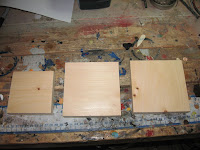













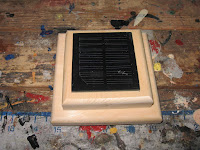


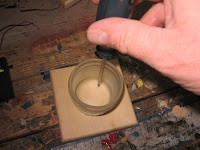



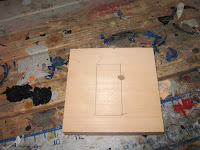







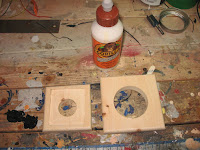


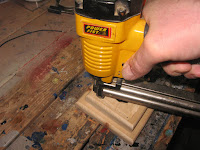
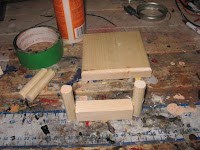
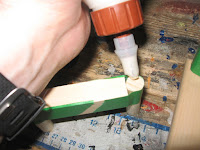
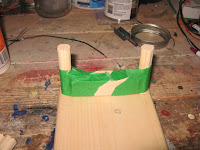





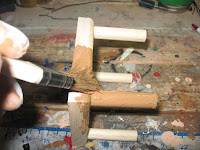










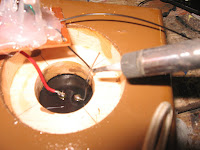

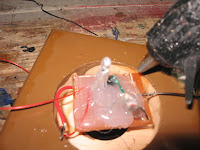


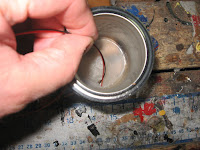





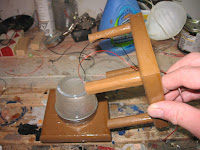

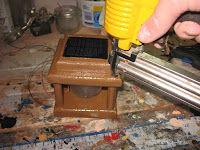





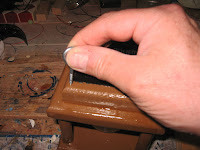
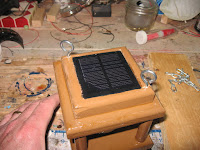





No comments:
Post a Comment